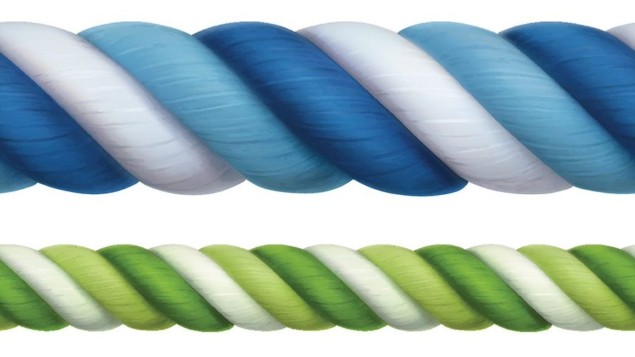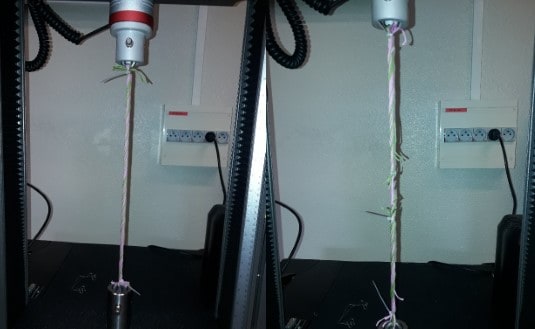
This article has been updated to include comments from Raymond Goldstein and Patrick Warren.
It is a mathematical puzzle that stumped Galileo, but researchers in France think they have discovered how rope and yarn fibres held together by nothing more than friction are able to carry heavy loads without breaking. Jérôme Crassous of the Institute of Physics of Rennes and Antoine Seguin of the Université Paris-Saclay have shown that small twists in a rope multiply into massive frictional forces that lock the fibres together.
Their approach, which combined experiments and simulations, has sparked a discourse about whether yarn fibres undergo a second order phase transition when they are spun together.
Crassous illustrates the yarn twisting problem with a simple demonstration. He holds two brushes (tassels) of cotton fibres, one in each hand. When the brushes are interleaved, they can be pulled apart easily. But, as soon as he starts to twist the interleaved brushes to create a yarn, they become almost impossible to separate. Since Galileo’s time, our interpretation of this experiment has evolved with our understanding of forces and friction, but a complete model remains surprisingly elusive.
The yarn twisting problem
To understand why twisting fibres makes a yarn stronger, imagine trying to push a box along by pushing diagonally downwards rather than parallel to the floor. Because you are pushing into the ground, you create an additional frictional force, and the harder you push, the harder the box is to move.
When you twist two fibres and try to pull them apart, you are trying to move the strands by pushing them into each other as well as pulling them. This tiny frictional force, multiplying rapidly as thousands of fibres are spun together, gives yarn a strength that is far greater than the sum of the individual strands.

Developing a working mathematical model of how this happens has proved difficult. In 2018, UK-based scientists at the Universities of Warwick and Cambridge and Unilever proposed that the locking of the fibres at some critical twist angle is a second order phase transition. Their theory says that at this angle, the maximum tension (stretching force) that the yarn can endure diverges, meaning that if the fibres are strong enough, there is no limit to the load that it can hold.
Crassous and Seguin wanted to test this theory experimentally. This involved clamping the interleaved cotton brushes at one end and applying a fixed angular twist to create a yarn. A stretching force was then applied to the finished yarn and the duo measured the maximum tension in the yarn before it broke.
Does yarn have a second order phase transition?
As they approached the maximum twist the yarn could sustain, Crassous and Seguin watched the maximum load suddenly shoot up. But Crassous does not think their experiments support the 2018 theory from Unilever and Warwick and Cambridge Universities. When they analysed their data, they found that yarn strength scaled with the exponential of the square of the twist angle. Although the yarn eventually breaks, Crassous does not believe that it was heading for a second order phase transition. Instead, he likens the process to the formation of a glass, where viscosity increases rapidly but the material still has a liquid structure.
However, Raymond Goldstein and Patrick Warren, two of the authors of the 2018 paper, argue that the two systems are not comparable and maintain the possibility of a second order phase transition. In 2018 Goldstein, Warren and Robin Ball modelled the fibres as hooking around their neighbours as well as twisting into a rope. They hypothesize that this was not present in Crassous and Seguin’s experiment, but would be enough to lock the fibres together in systems like yarns and sewing threads. The experimental proof or disproof of a second order yarn transition, they conclude, remains undecided.

Physicists explain why clothes do not fall apart
The researchers also performed numerical simulations and found that they could predict the amount of twisting that would turn the tangle of fibres into a strong yarn. The ratio of the fibre dimensions and the friction coefficient, which they call the “Hercules number” determines whether a yarn forms, and Crassous is confident that this bolsters their results, saying “we have identified all the physics in the system if there is only one number”.
More research is needed to prove or disprove the existence of a yarn phase transition, but intriguingly, these latest results echo another, seemingly vastly different problem. It is nearly impossible to pull two interleaved phone books apart, the force pulling them together is strong enough to lift a car. Interleaving the pages creates normal forces, which amplifies the friction, much like the yarn experiment. This frictional force scales with the exponential of the square of the number of pages, a similar law to the yarn problem, indicating that the physics driving these two phenomena are related. The research is described in Physical Review Letters.



